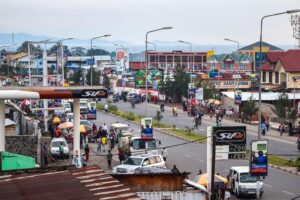Welcome to Carbon Brief’s DeBriefed.
An essential guide to the week’s key developments relating to climate change.
This week
Pakistan and India floods
EXTREME WEATHER: Heavy flooding forced half a million people to evacuate their homes in just 24 hours in Pakistan’s Punjab this week, the Associated Press reported. It brings the total number of people displaced since last month to 1.8 million, the newswire said. According to Arab News, at least 41 people have died as a result of the flooding since last week. The flooding has also destroyed thousands of acres of crops in Punjab, a province that accounts for 68% of Pakistan’s total annual food grain production, Bloomberg reported.
CROSS-BORDER EVENT: Meanwhile, in Indian Punjab, “at least 30 people have died and more than 354,000 have been affected” by flooding, BBC News reported. India also warned Pakistan about more cross-border flooding for the second time in as many weeks, as both countries reeled from monsoon rains, the Associated Press reported.
UK dividing lines
NEW FACE: Zack Polanski has been elected as the new leader of the Green Party of England and Wales in a landslide victory, the Financial Times reported. Polanski is an “outspoken campaigner who has argued his party needs to ‘connect with people’s anger’ and become more combative against ‘villains’, including oil major Shell and the ‘super-rich’”, the newspaper said. Polanksi wants to “replace” the ruling Labour party on a platform of “eco-populism”, according to BBC News.
NORTH SEA OIL: Meanwhile, the UK Conservative leader Kemi Badenoch pledged to drill “all” of the remaining oil and gas in the North Sea if elected, BBC News reported. [The Conservatives are polling third, at 17%.] In response to the speech, the Daily Telegraph‘s world economy editor Ambrose Evans-Pritchard argued that Badenoch’s plan would not “raise this country’s long-term output of oil and gas by more than homeopathic amounts” nor “move the needle on UK energy prices” (more below).
Around the world
- HIGHER AMBITIONS: The UN urged countries to set new, more ambitious national climate plans this month, ahead of this year’s COP30 summit in Belém, Brazil, Reuters reported.
- ‘JUNK SCIENCE’: A group of more than 85 climate scientists released a “scathing review” of the Trump administration’s misleading climate report, DeSmog reported.
- FOSSIL ENERGY: Russia said China had agreed to a massive new pipeline capable of importing as much as 50bn cubic metres of gas a year, the Financial Times reported.
- US PRESSURE: Reuters reported that the US is pressuring other countries to reject a UN deal on cutting emissions from shipping by threatening them with tariffs, visa restrictions and port levies.
- SWELTERING HEAT: Authorities in Japan and South Korea said 2025 was the hottest summer in their countries since records began, Al Jazeera reported.
- MITIGATION WORK: According to Bloomberg, Zimbabwe has published draft regulations to establish a National Climate Fund. The fund will finance projects “aimed at mitigating the impact of climate change and respond[ing] to emergencies”.
20%
The amount by which clean-energy production has surged in India this year, according to Reuters, citing data from the thinktank Ember.
Latest climate research
- “Extreme cold surges” have “robustly weakened in middle-to-high latitude continents during autumn and winter” due to climate change, according to a study in Nature Communications.
- A study published in npj Climate Action found that exposing people to moral appeals results in overall carbon footprint reduction and increased participation in civic and political climate action, regardless of ideological affiliation.
- The World Bank’s increase in climate finance spending since the Paris Agreement has been driven by projects with “low climate components”, according to a study in Climatic Change.
(For more, see Carbon Brief’s in-depth daily summaries of the top climate news stories on Monday, Tuesday, Wednesday, Thursday and Friday.)
Captured

A claim that gas produced in the North Sea emits “four times” less CO2 than imported liquified natural gas (LNG) featured prominently in both the Guardian and the Daily Telegraph this week, following Badenoch’s pledge to drill “all” the remaining oil and gas in the UK. However, this figure is highly misleading. It only refers to the emissions that come from the process of extracting and delivering the gas, which are much smaller than those from burning it. When both extraction and burning of the gas are taken into account, CO2 emissions from UK production are only around 15% lower than those from LNG imports, according to a new factcheck from Carbon Brief.
Spotlight
A man-made lake threatened by climate change
This week, Carbon Brief reports on how climate change is impacting the sustainability of a scenic nature reserve in the southern US.
In 1941, as World War 2 thickened, the US Congress approved a plan to construct a reservoir storage project on the Hiwassee River, a water body that cuts across the states of Georgia, North Carolina and Tennessee.
The dam, which came to be known as Chatuge after an 18th-century Cherokee village, was originally built for power generation purposes. However, after it was completed, it became more than a hydroelectric project.
In May 1942, the Towns County Lions Club started stocking fish in the newly created Lake Chatuge. In 1944, Clay County leased a tract of land for a public park.
Today, the park offers “scenic mountain views” and “panoramic views” of Lake Chatuge. The lake is also home to rare, endangered plant species and is an important source of drinking water.
However, Lake Chatuge’s future has been plunged into uncertainty after the Tennessee Valley Authority proposed a plan to repair the dam’s spillway, which could involve draining the lake’s water levels by 20 feet (6m) for up to eight years.
The TVA’s action is largely forward-thinking. While the dam and its spillway are in good condition, the public utility company is wary of extreme weather events made more likely by climate change.
In September 2024, Hurricane Helene tore through parts of Georgia and North Carolina, leaving more than 128 people dead across the US and uprooting communities in its wake. One analysis estimated that 44% of the economic damage from the storm can be attributed to human-caused climate change.
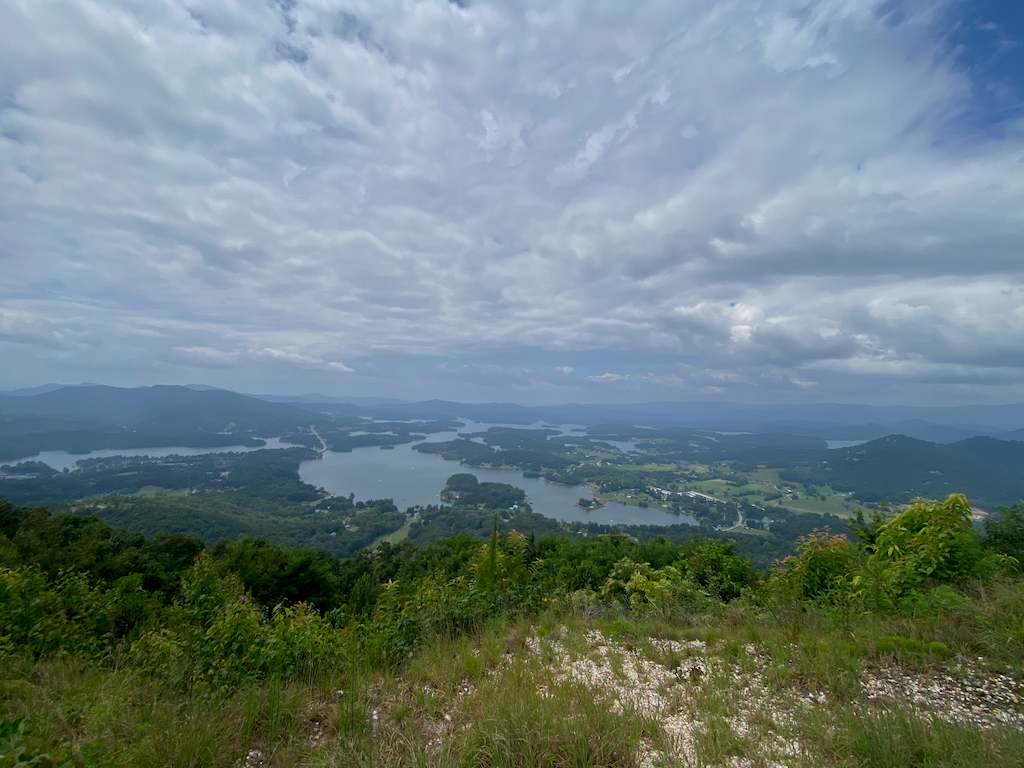
The Lake Chatuge area was largely spared, but officials worry that the next extreme weather event may not be far off.
“It’s the kind of event – the unusual storm event that can happen, that’s pretty rare – is what we’re looking out for,” a TVA project manager has said.
Meanwhile, aside from the imminent repairs made more likely by the increased possibility of extreme weather events, Lake Chatuge is also battling a parrot feather infestation, a phenomenon involving the spread of an invasive plant that has been linked to global warming in other parts of the US.
Saving Lake Chatuge
The threat posed by climate change to Lake Chatuge is not an isolated case. A July 2025 report by researchers at Utah State University found that climate change is affecting the social benefits of dams across the country.
Elsewhere in the world, the impact of extreme weather on ageing dams is wide ranging, including recently heightening tensions between India and Pakistan.
However, community members in the Lake Chatuge area are not giving up easily. A Facebook group dedicated to saving the lake has more than 2,000 members.
“Lake Chatuge is our economy,” Towns County’s sole commissioner, Cliff Bradshaw, told Carbon Brief. He added:
“The main attraction to this area is Lake Chatuge. Without the lake, the county’s tourism would drop, and our economy would suffer greatly – could even drive the county into a depression – as we have a great deal of businesses that rely solely on activities on Lake Chatuge for their customers, such as marinas, party boats and water activity playgrounds. The other businesses in town may not rely on the lake for customers, but do rely on the tourist traffic brought into the area by the lake to drive customers into their place of business.”
According to reporting by the Atlanta-Journal Constitution, visitors have spent up to $100m annually in the area since 2021.
The TVA’s repair work could begin as soon as 2027, but community members are asking both the public utility company and political leaders to help find the least damaging pathway.
Watch, read, listen
SCIENCE CUTS: The Financial Times reported on how the Trump administration has “gutted” the Federal Emergency Management Agency (Fema), throwing into doubt the nation’s ability to respond to extreme weather disasters.
SUSTAINABLE ECONOMICS: In an interview with Le Monde, the French economist Thomas Piketty argued that protecting the planet from climate change requires wealth redistribution.
TWEAKING NATURE: A Havard atmospheric chemist and an Oxford planetary physicist discussed the nuances and subtleties of geoengineering on the podcast Entanglements by Undark.
Coming up
- 8 September: Norway election
- 8-12 September: 54th Pacific Islands Forum Leaders Meeting, Honoraria, Solomon Islands
- 9-23 September: 80th Session of the UN General Assembly, New York
Pick of the jobs
- Energy UK, policy manager | Salary: £38,450. Location: London
- CNN Digital, climate and weather editor | Salary: $91,000-$169,000. Location: Atlanta, Washington DC, New York, Chicago or Burbank, California
- The Post and Courier, rising waters reporter | Salary: Unknown. Location: South Carolina, US
- The Seattle Times, climate reporter | Salary: $75,000-$90,000. Location: Seattle, US
DeBriefed is edited by Daisy Dunne. Please send any tips or feedback to debriefed@carbonbrief.org.
This is an online version of Carbon Brief’s weekly DeBriefed email newsletter. Subscribe for free here.
The post DeBriefed 5 September 2025: Pakistan floods hit 1.8m people; UK ‘eco-populism’; How warming threatens a man-made lake appeared first on Carbon Brief.
Greenhouse Gases
IEA reiterates ‘no new oil and gas needed’ if global warming is limited to 1.5C
The world would not need to invest in new oil and gas projects if demand for the fuels fell in line with the 1.5C limit on global warming, says the International Energy Agency (IEA).
The agency has been under attack from the Trump administration in the US for saying that fossil-fuel use is on track to peak this decade, given current policies and firm political pledges.
But, in a new report, the agency reiterates its 2021 finding that no investment in new oil and gas would be needed in a 1.5C world, albeit with some caveats.
The report also sets out how the oil-and-gas industry has been needing to “run fast to stand still”, spending around $500bn per year just to keep output at today’s levels.
It says this is due to output falling faster than previously thought at the world’s oil and gas fields, with an increasing reliance on shale oil and gas projects that face rapid rates of decline.
Amid growing calls for further licensing in the North Sea, the IEA also notes that new exploration licenses take an average of nearly 20 years to deliver additional oil and gas production.
Turning unconventional
The IEA report begins by arguing that discussions on the future of oil and gas “tend to focus on the outlook for demand, with much less consideration given to how the supply picture could develop”.
This is why the IEA has published a report on the rate of decline at existing oil and gas fields, as well as looking at where these fuels come from today and how this might change in the future.
Over the past quarter-century, global oil supplies have risen by a third, as shown in the figure below. At the same time, the source of those supplies has shifted towards “unconventional” resources, such as “tight oil” from shale formations (red) and oil sands (orange).

Shale gas is also behind much of the growth in global gas production over the past 25 years, shown by the green wedge in the figure below.
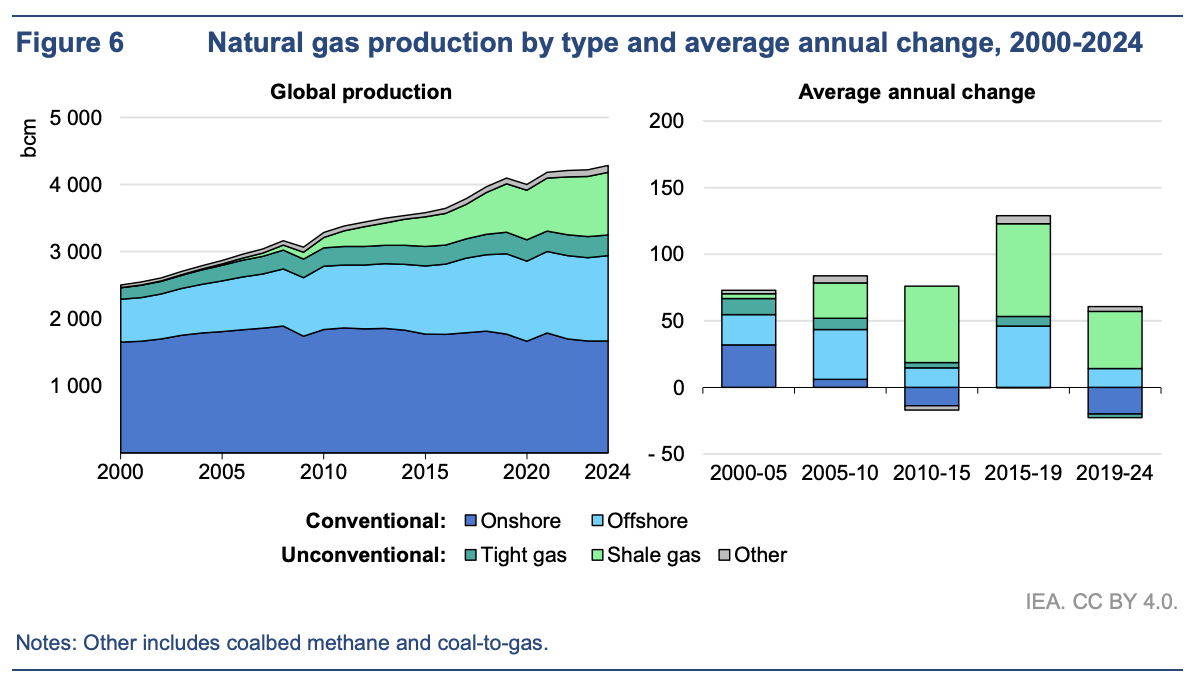
Accelerating decline
The shift towards unconventional resources, such as shale oil and gas, means that the output from existing fields will decline ever-more steeply without continued investments.
Indeed, the IEA report shows that this is already the case, with global “decline rates” for both oil and gas getting steeper – and the trend set to accelerate – as shown in the figure below, for gas only.
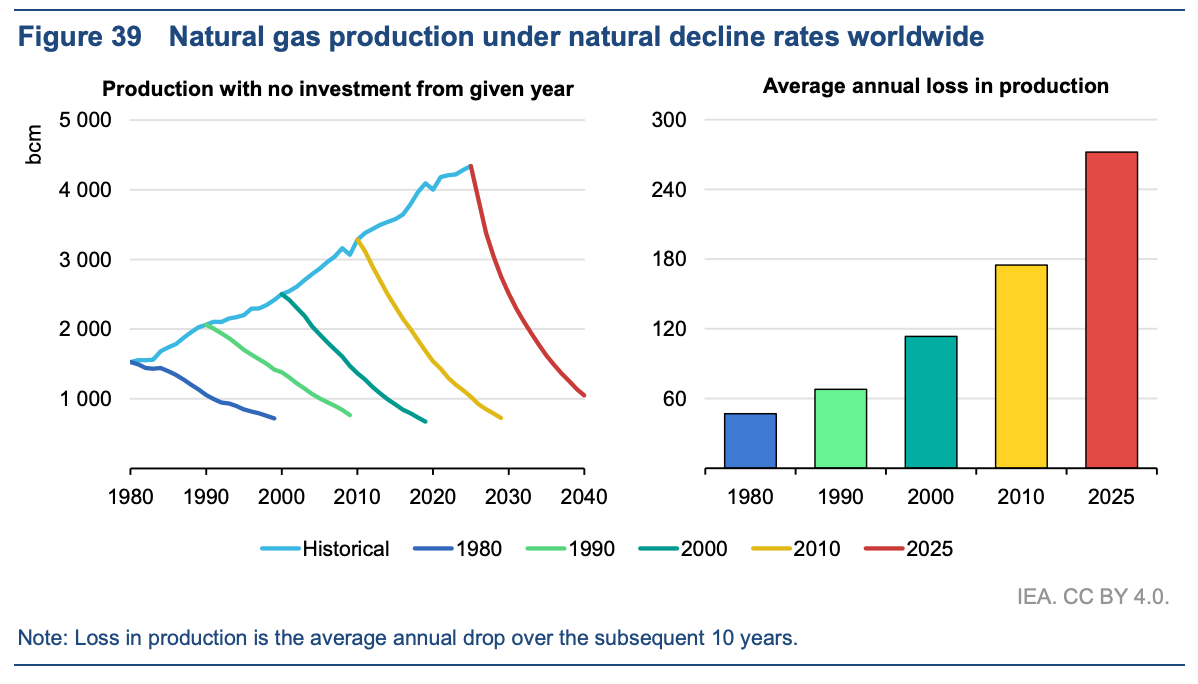
The consequence of these accelerating rates of decline is that the oil-and-gas industry is already needing to “run fast to stand still”, the IEA report explains.
It notes that nearly 90% of annual upstream investment in the sector since 2019 has been “dedicated to offsetting production declines rather than to meet demand growth”.
The industry needs to invest around $500bn per year, just to maintain current output, it says.
With investment set to reach $570bn in 2025, the IEA notes that this is enough to sustain “modest” production growth, but only a “small drop” away from flat or declining output.
The IEA also notes that around the world, on average, there is a delay of nearly 20 years from the issuing of oil and gas exploration licenses, until additional production starts to flow. It explains:
“This includes five years on average to discover the field, eight years to appraise and approve it for development, and six years to construct the necessary infrastructure and begin production.”
(In a recent speech pledging to “maximise extraction” of oil and gas from the North Sea, if elected, the UK’s opposition Conservative leader Kemi Badenoch talked of the need for new licenses.)
Need for new investment?
The IEA report goes on to show that without continued investment in maintaining output, global oil and gas production would plummet, as shown in the figure below.
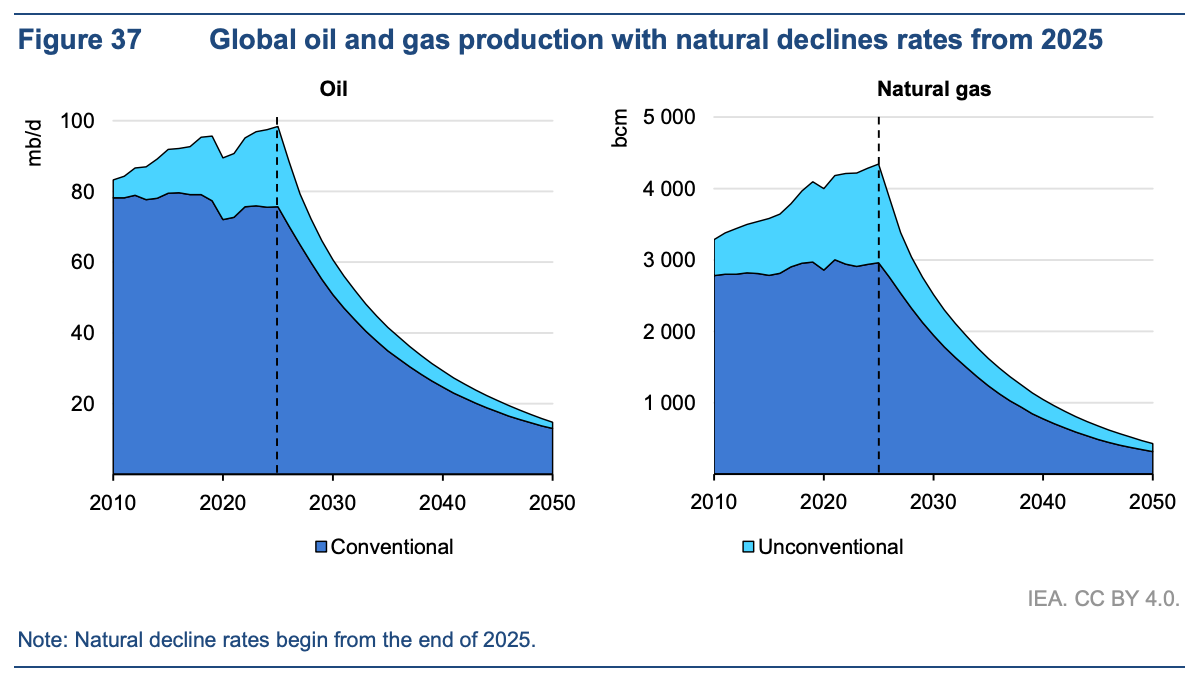
The Financial Times said the IEA report illustrated the “costly battle” facing the oil-and-gas sector if it wants to maintain current output.
However, the newspaper added that the sector would likely welcome the findings:
“The IEA’s findings are likely to be greeted enthusiastically by the oil industry, which has consistently maintained that it needs to spend heavily to maintain its current production levels.”
The catch is that the report also spells out the implications of falling demand, in a world that limits warming to below 1.5C above pre-industrial levels.
In the 1.5C-compliant “NZE scenario”, the IEA says that a “huge acceleration in the pace of energy transitions relative to current trends” would see oil and gas demand falling dramatically.
It adds that if this drop in demand were to happen, then no investment in new oil and gas production would be needed, as shown in the figure below. Specifically, the IEA report says:
“The pace of demand reduction in the NZE [1.5C] scenario is therefore sufficiently rapid that, in aggregate, no new long lead-time conventional upstream projects would need to be approved for development.”
(The IEA says that even in this 1.5C-compliant “NZE scenario”, there would still need to be some investment in “existing and approved” projects, to balance decline rates.)
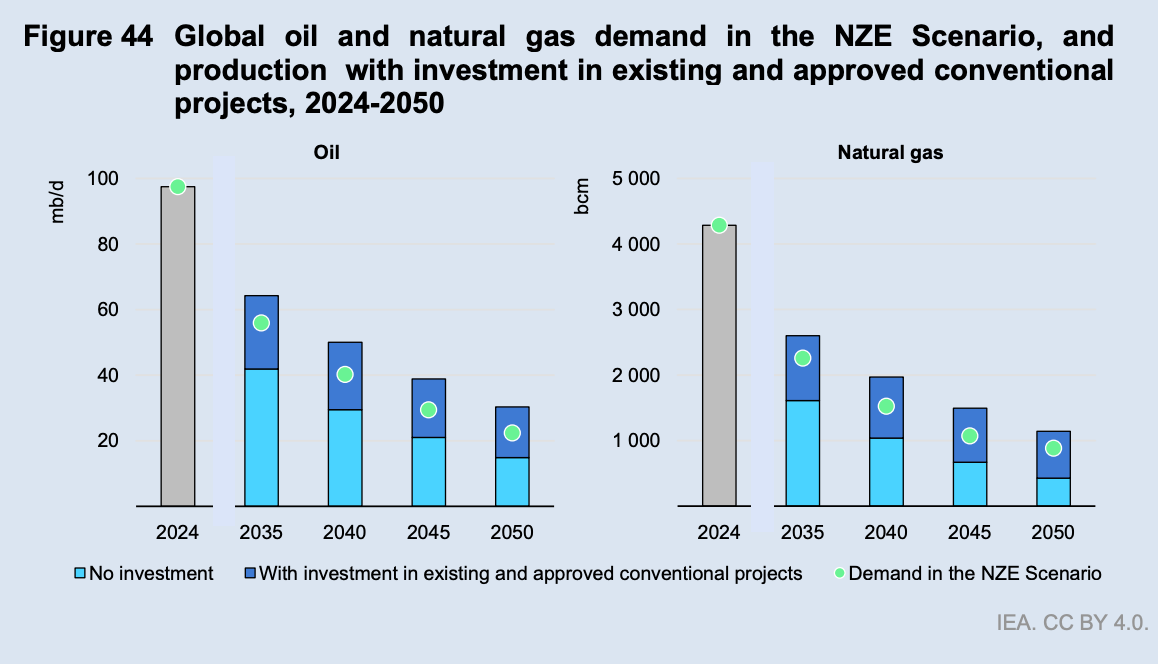
The new report, thus, reiterates the IEA’s previous finding that no investment in new oil and gas would be needed if the world got onto a 1.5C path.
However, it puts the emphasis more firmly on the need for demand to decline, in order to eliminate the need for new investment, contrasting with the way this finding has been widely reported.
In its coverage of the 2021 finding, for example, the Guardian reported that oil and gas development “must stop…if the world is to stay within safe limits”.
On the contrary, the new IEA report says that investment in new oil-and-gas development will be needed to meet demand, unless demand is dramatically reduced in line with the 1.5C limit.
In addition to making this point more firmly, the IEA report notes that a swathe of the highest-cost oil and gas projects in the world would need to close early – effectively becoming stranded assets – if demand for the fuels declines in line with the 1.5C limit. It says:
“[T]o ensure a smooth balance between supply and demand, declines in demand in the NZE scenario would lead to the early closure of several higher cost projects before they reach the end of their technical lifetimes. In 2050, for example, around 8mb/d of oil production and 250bcm of gas production would be retired earlier than would be implied by observed decline rates.”
The post IEA reiterates ‘no new oil and gas needed’ if global warming is limited to 1.5C appeared first on Carbon Brief.
IEA reiterates ‘no new oil and gas needed’ if global warming is limited to 1.5C
Greenhouse Gases
Rooted in our relationships: A tree planting for Senator Stabenow
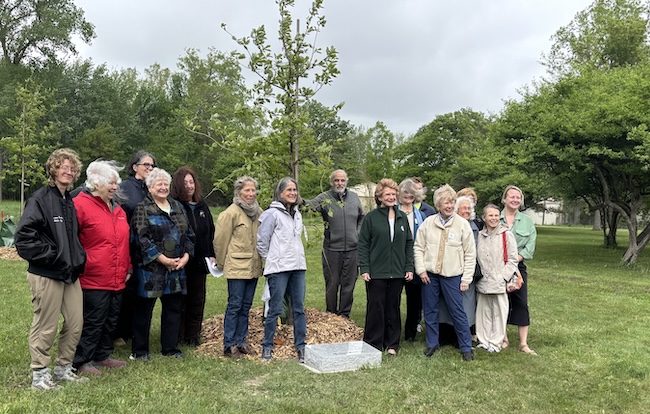
CCL Michigan volunteers and other community members pose with Sen. Stabenow
Rooted in our relationships: A tree planting for Senator Stabenow
By Flannery Winchester
In CCL, we put a big emphasis on relationships — not just with each other and in our communities, but with our members of Congress, too. And in any strong relationship, you take time to honor the milestones and the big moments.
One of those moments came for Sen. Debbie Stabenow when she decided not to seek re-election in 2024. CCL leadership in Michigan wanted to celebrate her climate efforts, after working with her for more than 10 years.
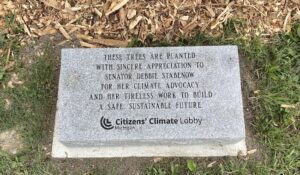 “The group decided that planting trees in the newly named Debbie Stabenow Park in Lansing would be an appropriate, long-living, public testament to her environmental legacy,” said Linda Racine, co-State Coordinator for CCL Michigan.
“The group decided that planting trees in the newly named Debbie Stabenow Park in Lansing would be an appropriate, long-living, public testament to her environmental legacy,” said Linda Racine, co-State Coordinator for CCL Michigan.
Volunteers across the state raised money to plant a cluster of trees and to commission an engraved stone that will provide a lasting tribute to “her climate advocacy and her tireless work to build a safe, sustainable future.”
The official dedication was held earlier this year, on Saturday, May 17. In addition to CCL volunteers and Sen. Stabenow herself, attendees included the mayor of Lansing, Andy Schor, and staff from the offices of current Michigan Senators Gary Peters and Elissa Slotkin.
Sen. Stabenow’s remarks
At the event, Sen. Stabenow spoke about the progress she’s seen on the bipartisan climate conversation over the years.
 She shared that in her early days in office, she held a hearing on “severe weather” rather than climate in order to make the topic more accessible to her colleagues across the aisle.
She shared that in her early days in office, she held a hearing on “severe weather” rather than climate in order to make the topic more accessible to her colleagues across the aisle.
She said, “We’ve come a long way since then, and all of you have been really important in this process.” As evidence of that progress, she mentioned the Growing Climate Solutions Act, a bill she led with then-Senator Mike Braun of Indiana.
“The Growing Climate Solutions Act was the only bill that has ever passed the Congress with the word ‘climate’ in the title,” Sen. Stabenow highlighted. The bill enjoyed broad bipartisan support and CCL supported it at every step of the way.
Sen. Stabenow closed her remarks telling the CCLers, “What you do is very important. Don’t give up on it. It’s easy right now to think it doesn’t make a difference, but […] I’m just urging you to keep it up.”
She acknowledged the wider political context of climate and clean energy under the current administration, saying, “The only thing that’s going to slow this down is engaged citizens. And the Citizens’ Climate Lobby has been at the forefront.”
A CCL-supported climate legacy
Sen. Stabenow’s climate action didn’t stop — or start! — with the Growing Climate Solutions Act.
She produced a 2019 report, Climate Crisis and Michigan, which called attention to the impact of a changing climate on agriculture, the state’s economy, the Great Lakes, and public health. Her report also described how Michigan could lead the way in clean energy, boosting the economy and creating jobs.
Then, as Congress worked on the Farm Bill, Sen. Stabenow’s staff met with CCL volunteers who have agriculture and forestry expertise, including three members of our Agriculture and Forestry Action Team and another CCLer who works as a forestry manager.
Sen. Stabenow also joined the bipartisan Senate Climate Solutions Caucus in 2020, fostering better dialogue on climate among her Senate colleagues.
Her engagement on the climate issue was steadily supported and encouraged by CCL Michigan volunteers who, over the years, have generated at least 8,599 letters and 2,758 calls to her office. (We say “at least” because the numbers are likely even higher — CCL Michigan’s relationship with Sen. Stabenow goes back even further than CCL’s current action tracking system!)
Michigan CCLers also held at least 64 meetings with Sen. Stabenow or her staffers in her Michigan offices, on Capitol Hill, or virtually.
“During COVID (2020), she met with 150 Michigan volunteers from our 17 chapters across the state on Zoom, and we had a chance to hear her thoughts on various climate policies being considered at the time and how we could help,” Linda said.

Several of CCL’s former liaisons to the Senator were in attendance at the tree planting, including Lisa DelBuono. “The whole event was warm, despite the temperatures, wind, and mist. I think it touched the heart of the Senator and all those who attended,” Lisa said.
Another former liaison to Sen. Stabenow, Sue Holcomb, said, “Planting trees in Sen. Stabenow’s honor at a park where she raised her children and now takes her grandkids — her park — is beyond words fabulous. It is a forever commemoration of her work, CCL’s work with her, and the power of natural solutions like trees to heal our planet.”
The post Rooted in our relationships: A tree planting for Senator Stabenow appeared first on Citizens' Climate Lobby.
Rooted in our relationships: A tree planting for Senator Stabenow
Greenhouse Gases
Analysis: IPCC’s seventh assessment has record-high representation from global south
The upcoming assessment cycle of the Intergovernmental Panel on Climate Change (IPCC) will be authored by more experts from global south institutions than ever before, Carbon Brief analysis finds.
More than 660 scientists from 90 countries have been selected to write the three “working group” reports that will form the core of the IPCC’s seventh assessment cycle (AR7).
These three reports are scheduled to be published by 2029 and will summarise the latest research on climate change.
Carbon Brief analysis finds that a record 42% of authors of these upcoming reports are based at institutions in the global south.
Overall, the AR7 working groups will have an equal 50-50 representation of authors who are citizens of the global north and global south.
The analysis shows that the UK has the highest number of authors at 59, followed closely by the US with 55.
Furthermore, Carbon Brief finds that 46% of the report authors are listed as “female” – the second-highest percentage to date for any group of IPCC reports.
In a statement, IPCC chair Prof Jim Skea said the new author teams “reflect increased diversity, in terms of both gender balance and greater representation from developing countries and economies in transition”.
Countries
Earlier this year, Carbon Brief published an analysis of the gender and country of affiliation of the authors of all major IPCC reports, from the first assessment report in 1990 to the sixth assessment report (AR6) in 2023, including working group reports, special reports and methodology reports.
Carbon Brief has now expanded the analysis to include the authors of the AR7 working group reports, which are expected to be published by 2029.
For scientists to become IPCC authors, they must nominate themselves or be nominated by someone else to their country’s “national focal point”, which is often the country’s ministry of environment, climate change or meteorology. It is the focal point’s job to assess the applications and send a subset to the IPCC for their consideration.
The final decision on authors lies with the IPCC bureau – which consists of the chair and vice-chairs, as well as a pair of co-chairs for each working group.
The IPCC’s seventh assessment cycle will feature three working group reports:
- Working Group I (WG1): The physical science basis
- Working Group II (WG2): Impacts, adaptation and vulnerability
- Working Group III (WG3): Mitigation of climate change
Across the three working groups, Carbon Brief finds that 42% of the authors are affiliated with institutions in global south countries. This is a record high for any set of IPCC assessment reports.
The chart below shows the percentage of global south authors from every set of IPCC reports ever published.

Each IPCC assessment cycle is marked by the publication of three working group reports, which are summarised in a synthesis report. Carbon Brief has grouped these four reports under the headline “assessment reports” for every assessment cycle.
(“AR7” includes only the three working group reports, as the author list for the synthesis report has not yet been released.)
The first, second and third assessment reports are indicated by the acronyms FAR, SAR and TAR. Subsequent assessment reports are indicated by AR, followed by the name of the assessment cycle.
Most assessment cycles also saw the publication of “special reports”, focusing on specific areas of climate change, and “methodology reports” – technical documents that focus on specific areas of the IPCC’s methodology. Acronyms for these reports are given as SR and MR, respectively, followed by the name of the assessment cycle.
For example, the special reports on 1.5C, the ocean and cryosphere and climate change and land – published over 2018-19 – are part of the sixth assessment cycle and are referred to collectively as SR6.
(To assign each special and methodology report to an assessment cycle, Carbon Brief assumes that assessment reports are the last documents to be published in each assessment cycle. Carbon Brief has grouped the authors from special reports (“SR”) and methodology reports (“MR”) separately for each assessment cycle.)
Carbon Brief defines the global north as North America, Europe, Japan, Australia and New Zealand. It defines the global south as Asia (excluding Japan), Africa, Oceania (excluding Australia and New Zealand), Latin America and the Caribbean.
While the three AR7 working group reports collectively have the highest percentage of global south authors compared to other similar groupings, there are individual reports with higher percentages, such as the 2019 special report on land and 2023 synthesis report.
Carbon Brief finds that, with 59 appointed authors, the UK is the most highly represented country in the upcoming IPCC working group reports.
This is closely followed by the US with 55. Rounding off the top five are Australia, Germany and China, with 34, 32 and 29 authors each, respectively.
Comparing the number of authors in each continent shows Europe with comfortably the largest representation, at more than 200 appointed authors. At the other end of the scale, South America and Africa have the fewest authors, with around 80 and 70 authors, respectively.
Of these three reports, WG2 has the highest percentage of global south authors for the IPCC’s seventh assessment cycle, while WG1 has the lowest.
Institutions
Carbon Brief has also ranked which institutions have the largest numbers of IPCC authors. The table below shows the top 15 institutions and their country.
| Institution | Country | Number of authors |
|---|---|---|
| Imperial College London | UK | 10 |
| University of Cape Town | South Africa | 9 |
| Potsdam Institute for Climate Impact Research | Germany | 8 |
| National Centre for Scientific Research | France | 8 |
| CGIAR | International | 6 |
| ETH Zurich | Switzerland | 6 |
| University of Oxford | UK | 5 |
| University of Melbourne | Australia | 5 |
| International Institute for Applied Systems Analysis | Austria | 5 |
| National Institute for Environmental Studies | Japan | 5 |
| CICERO Center for International Climate Research | Norway | 5 |
| International Centre for Integrated Mountain Development (ICIMOD) | International | 4 |
| Environment and Climate Change Canada | Canada | 4 |
| Commonwealth Scientific and Industrial Research Organisation (CSIRO) | Australia | 4 |
| Independent/self employed | International | 4 |
With 10 authors, the UK’s Imperial College London – where IPCC chair Jim Skea worked for almost a decade – tops the list.
It is closely followed by South Africa’s University of Cape Town, which has nine authors. After this, with eight authors apiece are the Potsdam Institute for Climate Impact Research and the French National Centre for Scientific Research.
When Carbon Brief carried out similar analysis in 2018 for the IPCC’s sixth assessment cycle, the US led the pack with 74 out of the 721 authors and the National Oceanic and Atmospheric Administration (NOAA) had eight authors in total.
This year, the most highly ranked US institutions are Cornell University and Rutgers University, which list three authors each.
Only one author from NOAA was listed. This expert’s listing for “institution” specifies “until April 30, 2025 – then retired”.
This comes after disruption to the usual US federal nomination process for selecting IPCC authors.
In February, Donald Trump pulled the US out of a meeting in China to discuss the seventh IPCC assessment cycle, according to Earth.org. The outlet adds that he also ordered federal scientists at the NOAA and the US Global Change Research Program to stop work on all other IPCC climate assessment-related activities.
Citizenship and institution
IPCC authors have two countries listed next to their names – “country” and “citizenship”. For this analysis, Carbon Brief uses the former, which indicates the country where the scientist works, because citizenship data is not available in earlier reports.
However, there are dozens of experts with different countries listed under “country” and “citizenship”.
For example, 59 authors have the UK listed as their “country”, meaning that they work at institutions in the UK. However, 28 of these experts are citizens of other countries, including Kenya, Chile and Spain.
Of the 29 authors with Indian citizenship, nine are registered with institutions in other countries, including Nepal, Malaysia and the UK.
Meanwhile, 13 authors are registered with institutions in Saudi Arabia – including an employee from the oil company Saudi Aramco – but only five have citizenship there.
Carbon Brief finds that a record-high 280 experts are affiliated with institutions in the global south, making up 42% of total authors.
(While half of all authors are citizens of global south countries, citizenship information is not provided with all IPCC reports and so a full comparison throughout IPCC history is not possible.)
IPCC scientists previously told Carbon Brief that experts from the global south often find it easier to apply to join the IPCC via institutions in the global north.
Gender
The IPCC provides binary gender data for all the AR7 authors.
Carbon Brief finds that 46% of the authors of the IPCC’s seventh assessment working group reports are listed as women.
The chart below shows the gender balance of the authors of all IPCC reports ever published.

Of the three AR7 reports, WG2 has the highest proportion of authors who are women.
Just shy of 52% of the authors of the impacts, adaptation and vulnerability report are women, making it the IPCC report with the second-highest proportion of women authors, after the IPCC’s upcoming special report on cities with 53%.
Methodology
Carbon Brief downloaded authorship data on the AR7 working group reports from the IPCC website, which lists data on each author’s gender, citizenship and the country where their institution was based. Carbon Brief also obtained data from the IPCC’s technical support unit.
(The “methodology” section of Carbon Brief’s earlier 2025 and 2023 on IPCC authorship contains more details on how Carbon Brief collected authorship data from the main working group reports and recent special reports.)
Carbon Brief recognises that gender is not best categorised using a binary “male” or “female” label and appreciates that the methods used of determining author gender could result in inaccuracies. However, for the purpose of this analysis, this method was deemed suitable.
The post Analysis: IPCC’s seventh assessment has record-high representation from global south appeared first on Carbon Brief.
Analysis: IPCC’s seventh assessment has record-high representation from global south
-
Climate Change2 years ago
Spanish-language misinformation on renewable energy spreads online, report shows
-
Climate Change Videos2 years ago
The toxic gas flares fuelling Nigeria’s climate change – BBC News
-

 Greenhouse Gases1 year ago
Greenhouse Gases1 year ago嘉宾来稿:满足中国增长的用电需求 光伏加储能“比新建煤电更实惠”
-

 Climate Change1 year ago
Climate Change1 year ago嘉宾来稿:满足中国增长的用电需求 光伏加储能“比新建煤电更实惠”
-

 Carbon Footprint1 year ago
Carbon Footprint1 year agoUS SEC’s Climate Disclosure Rules Spur Renewed Interest in Carbon Credits
-
Climate Change2 years ago
Why airlines are perfect targets for anti-greenwashing legal action
-
Climate Change1 month ago
Guest post: Why China is still building new coal – and when it might stop
-
Renewable Energy2 months ago
US Grid Strain, Possible Allete Sale







